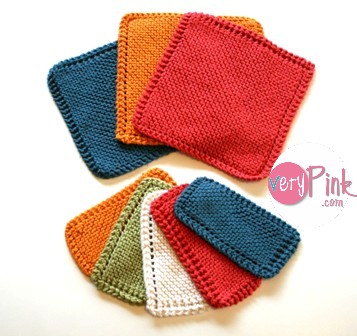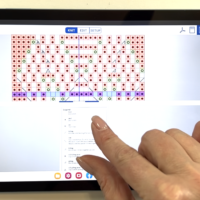
My free Learn to Knit a Dishcloth pattern + video tutorial has received a much-requested update. This update includes instructions for making rectangular dishcloths, any size.
Now, they’re all called “dishcloths”, regardless of the shape or size you make them. But I personally find the 9 x 9″ squares too big for washing dishes. Instead, I use them for tasks where I would otherwise use a paper towel – like wiping down counters, spill clean-ups, etc.
The 6 x 3″ rectangles in this pattern update are the size I like to use for washing dishes. They fit nicely in the hand, drape easily over the sink divider when not in use, and they dry quickly. The pattern explains exactly how to make this size, but it can be easily modified to make any size rectangle – up to a bath towel size, and beyond.
This pattern is a FREE RAVELRY DOWNLOAD.
The video tutorial will walk you through making the square dishcloth, but the techniques are exactly the same for the rectangles.



What a great idea. I’ve made several of the square dishcloths. I love the colors and am wondering what yarn you used.
For the ones in the photo, I used Knit Picks Comfy Worsted.
S t a c i
I don’t see where the pattern tells you how to make the 6×3 size.
I would like to make them.
thanks
Scroll through the pattern Deb – the instructions are there!
Thanks for the updated version. I will try it out. I’ve made the square one for a gift for my sister in law but she refuses to use it for the dishes, says it to nice and will only use it for a facecloth. Turned out my brother wanted one to. So I’ve made him the square one and another one with square pattern on it that I found on the internet. He’s into graphics so I’m sure he will like it.
I will add a couple of the smaller ones in his gift basket. Maybe they will use them for the dishes.
Thanks for the update! I’ve made several of the square dishcloths and, like you, prefer a smaller size for washing dishes. I can’t wait to cast these on.
Thanks!
Your videos seem a bit irregular lately, are you releasing them on a day other than tuesday now?
Is there going to be a regular release day for your videos anymore?
Nathan – I have always, and will always release a new video each and every Wednesday. Nothing has changed!
S t a c i
Hello Staci, I’ve made the little dishcloth. I did 24 stitches wide. As I was following the pattern I found where I had to repeat rows 1 and 2 for a total of 20 times (40 rows total) that it it would have been to long so I did row 1 and 2 for 30 times, it matched the wide of the larger dishcloth and seems to work well together as a set. Thanks again for the pattern.
Linda – thank you for the note! You just made me realize that I made a mistake…it is supposed to be 20 rows total – not 20 repeats of the two rows. I’m correcting the pattern now. Thanks again!
lol, I was going to write you and tell you mine turned out 3×10…way long.
I will make another with the corrected total of rows.
Thank you for the pattern.
Hi Staci,
Thanks for this update, I love these cloths they are so cute. I have already made many of the square ones.
BTW, I always love to see an email telling me that you have released a new video.
Thanks,
Tina
I just made one after you corrected the pattern. I love it. I really like doing dishes with this smaller one so much more. Thanks again for the great pattern.
on something like this, does yarn weight matter much?
I thought you did them on tuesdays for some reason, thanks for straightening me out! 😛
Thank you for this rectangle pattern! I started making them last nite! They are the perfect size.
Hi – thanks for the updated pattern! I have a couple of questions — the edge holes on the decrease section are always bigger than the yo holes. Is that typical? Also, the last stitch I bind off sticks out so the corner points to the left. Any solution for this?
Thanks again
~ Elizabeth
Elizabeth – that is normal, just the nature of knitting. After you wash and dry your dishcloths, you won’t see a difference anymore.
S t a c i
I have made these dish cloths and I love them. I was thinking of making them bigger and use as napkins, little bigger and they could be matching placemats; much smaller and they could be colorful napkin holders. Endless ideas.
Great idea for a Gift. Will Try it definitly.
The square dishcloth is actually the pattern that I used to teach myself how to knit using youtube. At the time the only yarn I had avalible was acrylic, but it still seems to do the job well enough. After the first one I made them smaller, 25 sts wide instead of the original 50, and gave them to my SIL to try after she complained about all the sponges she was buying and tossing, and she loves them. Now everytime I see her she wants to know if I’ve made any more and even other members of my family are requesting them. LOL At least they knit up quick.
Hi I’m new to knitting. I love the dishcloths and will try it out. Is there a way to watch the video in slower motion? Sorry, it’s just that your hands move so fast. Still learning how to coordinate my fingers, yarn and needles????
Hi Staci,
I love your tutorials. You make knitting look so easy. I have made these but by the time I get to the last few stitches the corner is pointy instead of rounded like the rest of the corners. Can you tell me what you think I’m doing wrong?
Thanks so much,
Barbara
I used the instructions for the rectangle dishcloth to make placemats out of cotton. They are 12.5 inches by 17.5 inches. Love them. Used nautical variegated cotton yarn. Great for patriotic holidays. You’re videos and patterns are the best. Thanks!
I have made dishcloths, especially the square one I know as ” grandma’s favorite”, for 35 years, since I first started knitting when I was 17. I never thought about making one in a rectangle shape ( I have often made small square ones)….brilliant idea Staci! I love your videos and patterns, even as a long time knitter, you have often help refresh my memory on how to do something. Thanks so much…..
Thank you for posting the rectangular pattern variation. I also (as mentioned by Sharon above) make smaller square versions of the original pattern. I start my decrease after knitting to 25 stitches and instead of the bumpy edges I always slip my first stitch to get a smooth edge.
I am trying to make the rectangular dishcloth. It looks straight in picture but mine are on the diangle, what am I doing wrong? thanks, Judy
I explain this and the reason for it in the video – once you get them wet (or apply steam), you can straighten them out to a perfect square.
S t a c i
I’m new to knitting and I like these dishcloths, and your videos, I was wondering if you have a video showing how to do the rectangle one, I’m having trouble getting it to work out , the area that is giving me a problem is the decreases . I look foward to your reply.
Becky – the same techniques are used in both versions of the dishcloth, which I demonstrate in the video. But no, I don’t have a video specifically on the rectangle version.
S t a c i
You mention not using wool, and that cotton works well. What about 100% acrylic. I have found myself with a stash that would be perfect for this dishcloth. Thanks! Love your videos!
Sue – the reason I recommend cotton or cotton blend yarn is because of how well cotton absorbs water and dries quickly. You can certainly make dishcloths with acrylic yarn, but they won’t be as nice as ones made with cotton.
S t a c i
Please help me with the following issue – I am writing you from Croatia where we never had a habit of using knitted kitchen cloths, so I wonder – are there three types:
1. dish cloth – using it to wash dishes (gets wet…)
2. hot cloth – the one that you use to take out warm things from oven, or put under the warm pan, etc… (hangs somewhere almost as decoration)
3. kitchen cloth – for wiping wet dishes? 🙂
If you agree with these types (and please add new or correct them :D) – which kind of yarn should be used for wet situations (no 1.) and which kind for hot situations (no 2.), etc.
Namely. I knitted one nice cloth… and it was there in the kitchen. Put very hot pan onto it – and it actually got brown marks and it smelled awful – it burned. So I realized probably has to be some amount of wool in it if using for hot situations. What percentage of wool, for what is good synthetics, etc.
I would be very grateful for an answer as I am totally into knitting kitchen cloths. I just did your chevron pattern and am sharing it with my friends, it is wonderful.
I and my 8-year old daughter follow your channel continuously and like it very very much (and can’t wait to try Portuguese style :D)
Thank you so much,
Ines